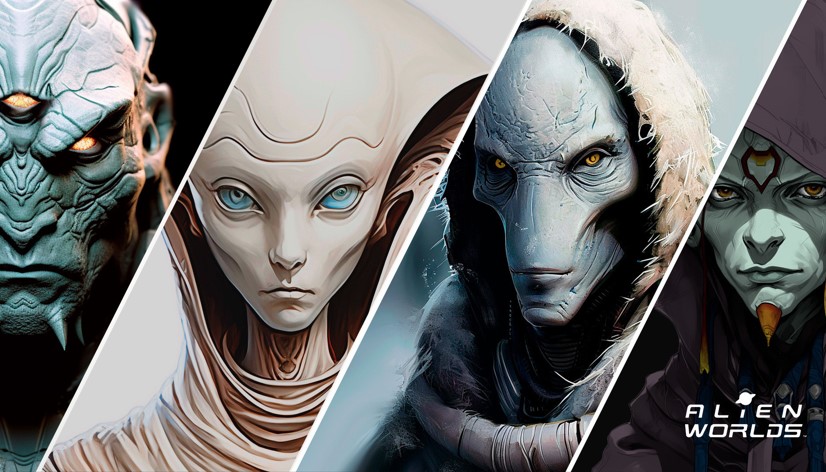AI didn’t kill the metaverse, it will build it
Hype over “the metaverse” was everywhere in 2022, with tens of billions poured into the sector. Largely substance and user-free at the time, the narrative was all but forgotten in 2023 as speculators excitedly jumped on board the AI train.
But generative AI is shaping up as a potentially new way for users to build the metaverse themselves — and by metaverse, we’re talking virtual worlds in which creators own a slice of the economy via blockchain and NFTs.
AI enables nonartists to generate imagery, enables non-developers to code programs, and basically allows anybody with a bright idea to pitch in to create new worlds and games.
That, at least, was AI Eye’s bright idea for a feature story in September last year, but despite interviewing luminaries from Sebastian Borget (The Sandbox) to Illia Polosukhin (Near) on the subject of AI building the metaverse, the story went nowhere as it was more concept than reality at the time.
And while it’s still too early to call it a confirmed trend, gaming metaverse Alien Worlds has firm plans to make the concept a reality.
A “Dune-meets-cyberpunk” game with 50,000 daily users created in 2021 by primary contributor Dacoco, it features six DAOs of tokenholders known as Planetary Syndicates who compete for a share of the elusive element of Trilium (a token, TLM).
The virtual universe is held together with world-building lore by Dune prequels author Kevin J Anderson, and Dacoco says that a majority of the artwork, from the alien races to the buildings, vehicles and landscapes, were created with the assistance of AI tools like Midjourney.
“We’re using AI to help generate a lot of the lore, the image, the images, the text. And we’re doing that based on the original spark that we built with Kevin J. Anderson. So we’re trying to do that quickly and at scale,” explains Kevin Rose, chief marketing officer of Dacoco.
The lore created by Anderson about new aliens, new technologies and new cultures has been fed into a Large Lore Model called Lynx (based on the open source Mistral 7B LLM), which coordinates the myriad different contributions to the metaverse into a unified canon on a GitHub repository using a combination of AI and 6,000 token voters. Users can query the LLM about the world built so far, analyze on-chain data and use it to help generate storylines.
“We are creating AI tools, both proprietary and all others, that can be used to allow people who can’t draw to build art, and allow people who can’t write, to accelerate stories, to expand on this canon.”
Rose clarifies that Lynx can’t generate art at this stage, but Dacoco is working on various ways to use AI to create consistent imagery.
One example of a user contributing to the lore and economy of Alien Worlds is Geoff McCabe from comic book and game company Lightning Works. He’s behind the NFT comic Starblind, which is set in the universe and sold as Polygon NFTs.
For McCabe, coordinating a vast user-built equivalent of the Marvel Cinematic Universe or Star Wars via AI and blockchain is a massive leap forward.
“Imagine if Star Wars basically told the whole world that you can come and make stuff for Star Wars now and make money off of it — it just has to be consistent,” he says.
“It’s way ahead of its time, so it’s going to be difficult for people to understand the importance of this until three or four years from now.”3

That said, when AI Eye asks for specific examples of AI-created content, Rose and McCabe offer up just a handful, including AI-generated characters for Starblind, using Lynx to create story arcs for community-built games and a platform-style game called Trilium Quest that uses NPCs controlled by AIs.
So a little like the metaverse in 2022, it still seems more conceptual than actual. But it’s a pretty cool concept.
“We want a groundswell of content, basically, and AI will help make that happen. So we’re in the beginning stages of that,” says Rose.
The easiest way to get involved is heading to Alienworld.io or by downloading the iOS app Battlefleet Armageddon.
AI is like crypto: DeepMind CEO
Talking of hype, that’s one of the big similarities between AI and crypto — the other being they are both new technologies the vast majority of people don’t understand.
DeepMind CEO Demis Hassabis worries about these similarities. “[AI] brings with it a whole attendant bunch of hype, and maybe some grifting and some other things that you see in other hyped-up areas—crypto, or whatever,” he told the Financial Times.
“Some of that has now spilled over into AI, which I think is a bit unfortunate. It clouds the science and the research.”
A classic example of the hype getting ahead of the technology came to a head this week with Amazon’s Just Walk Out technology being removed from stores. Promoted as a way AI could allow customers to simply pick up items and avoid the checkouts, it turned out that 1,000 contractors in India hired to review and train the tech ended up manually processing about 70% of the transactions.

And while no one doubts AI is here to stay, its use in professional settings will be limited until such time as the hallucinations and unreliability issues can be fixed. Some people are now starting to wonder where all the profits will come from for the hundreds of billions invested.
Société Générale’s chief global strategist Albert Edwards thinks the AI narrative propelling stock markets to record highs looks like a bubble.
“Every bubble has a compelling narrative,” Société Générale’s chief global strategist wrote in a note to clients.
“The current narrative centers on the anticipation of an AI-driven surge in corporate profits to fully justify the current stratospheric valuations. Those of us who lived through the late-1990s [tech] bubble have heard it all before and roll our eyes skyward.”
AI is saving lives, improving lives
AI Eye reported last year on the MIT team that used AI to find the first new antibiotic in 60 years to treat hitherto antibiotic resistant superbug MRSA.
Now, a team of researchers has published a paper in Nature that formalizes the process. The researchers created “SyntheMol,” a generative model that designs easy to synthesize new compounds, from a chemical space of nearly 30 billion molecules.
They tasked the AI with finding candidates for an antibiotic for another antibiotic resistant bug Acinetobacter baumannii, aka Iraqibacter, commonly picked up in hospitals. They synthesized 58 of the generated molecules and tested them, coming up with “six structurally novel molecules demonstrating antibacterial activity against A. baumannii and several other phylogenetically diverse bacterial pathogens.”
In another example of AI saving lives, an AI tool called Mia was tested for its ability to diagnose breast cancer on 10,000 mammograms against real-life NHS doctors. The AI not only picked up on all the tests showing symptoms but found 11 very early-stage cancers just a few millimeters in size the real doctors missed. Breast cancer patients whose tumours are under 15mm in size, when discovered, have a 90% five-year survival rate.

AI is also helping generate new patients by making beer taste better. Researchers from KU Leuven University in Belgium spent five years analyzing 226 chemical properties of 250 beers using AI and cross-referencing the results with professional and amateur beer reviews. They discovered they could improve any beer using a complex mixture of chemical properties that all of the real-world beer tasters agreed was better.
Study lead Professor Kevin Verstrepen said a unanimous vote “meant the beer really was better.”
Eric Wall vs Bittensor
Blockchain analyst Eric Wall appears to have wiped about $90 million off the market cap of Bittensor (TAO) with his devastating takedown of the AI crypto project on X. Wall was once known as the “altcoin slayer” and has form on criticizing projects that later turned out to be disasters like Terra Luna and Hex.
Wall used the example of Bittensor’s LLM-like “subnet 1” to argue the project was incredibly wasteful because users send a request, and 1,000 miners run LLMs and send back a similar response back in exchange for TAO tokens.
Also read: Reformed ‘altcoin slayer’ Eric Wall on shitposting and scaling Ethereum
“For every prompt, you have literally a thousand miners who will complete the exact same task redundantly,” he said, adding that answers are checked against each other, which incentivizes copying.
“There’s no AI magic to validate whether a model was actually run. There’s nothing that stops miners from copying replies from each other and tweaking them, spoofing their work.”
Bittensor investor Arca put out a blog to combat “incorrect information” and to argue it really wasn’t a “redundant ChatGPT clone attached to a worthless memecoin.”
The post points out there are a range of different subnets that focus on everything from creating products to building applications using decentralized search, or cloud services, and each has different incentive mechanisms to encourage contributions.
“Critiquing the entire network based on the perceived shortcomings of subnet 1 is like evaluating the Ethereum network on the basis of a single application.”
The post also takes issue with Wall’s claim that “all queries on a subnet are sent to every miner. In fact, only queries for the purpose of miner evaluation are distributed to the entire subnet. User-initiated queries are routed selectively, either to a single miner or a group, based on the validator’s routing strategy.”
However, it concedes that the “critique regarding the reward system holds some weight.”
After being piled on by TAO maxis, Wall warned that taking him on was like invading Russia.
“I don’t care if there is one million of you. You will all die of starvation and permafrost in these lands, I will outlast every one of you.”
All Killer No Filler AI News
— Fetch, SingularityNET, and Ocean Protocol are joining forces and merging tokens under the new banner of the Artificial Superintelligence Alliance. Voting on the merger into ASI closes on April 16. Read what Dr Ben Gortzel calls Magazine’s “wonderfully in-depth” feature on the topic.
— Tether has launched a new AI division and is looking for an engineer and head of research and development. The company’s post on the topic says the goal is to “build the next generation of open AI models” and is full of buzzwords like “innovation,” “privacy-preserving” and “democratizing,” but fails to shed much light on why a stablecoin firm needs an AI division.
— Degens who can’t be bothered to think up a name or supply for their token, can use AI to knock up a new memecoin token in about 20 seconds.
how to deploy the next billion dollar meme token on @base, world record speedrun:
-> https://t.co/acOU0K5aCZ pic.twitter.com/HEXamC4sp2
—
.eth (@CroissantEth) April 1, 2024
— Professor Jeremy Nguyen put together a simple guide for beginners on how to download and run Nomic’s GPT4All interface and an open-source model locally on a laptop to privately query your own documents. While the better the hardware the better the performance, users have been optimizing open-source models for CPUs that can run on low-end hardware like a Raspberry Pi.
— AI may end up widening the gender pay and employment gap. A survey of 1,048 Australians between 15 and 24 by KPMG found that while one-third of blokes are very interested and have a good understanding of AI (or so they say), only 24% of Gen Z women are interested, and only 20% say they have a good understanding. Separate research by New York University found the big LLMs tend to screen out resumes of job candidates who’ve taken maternity leave.
— LLMs can convince humans surprisingly well after being given access to personal information about them. A preprint study found that AIs were 81% more likely to persuade humans about an opinion than other human opponents. The results suggest a worrying future of personalized targeting of individuals with political and commercial advertisements.
week.

The post AI will build the metaverse says Alien Worlds, Eric Wall vs Bittensor: AI Eye appeared first on Cointelegraph Magazine.

